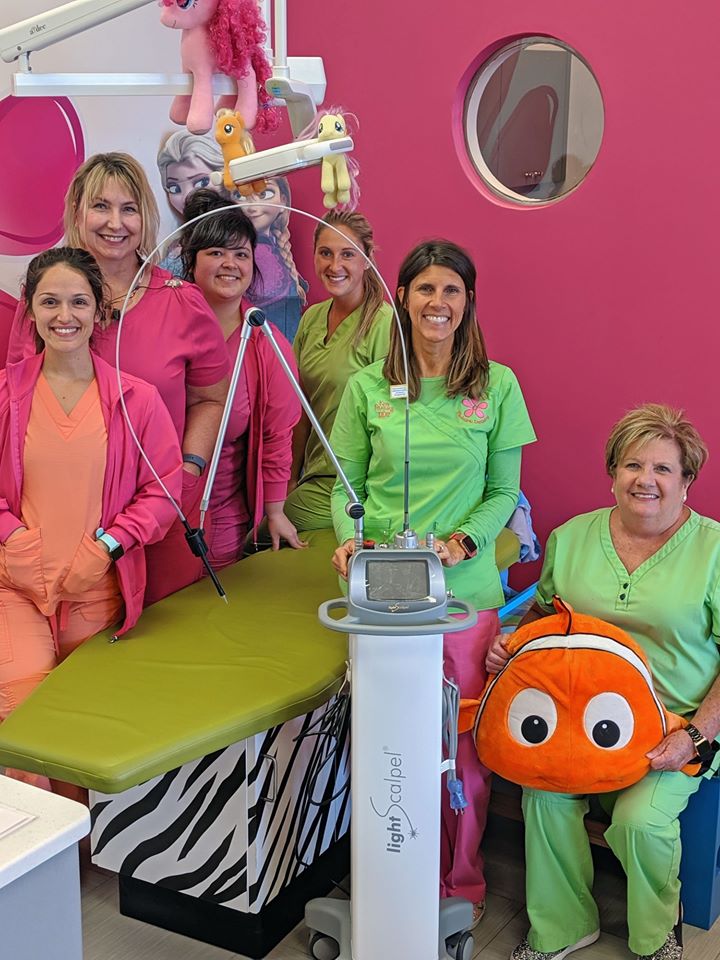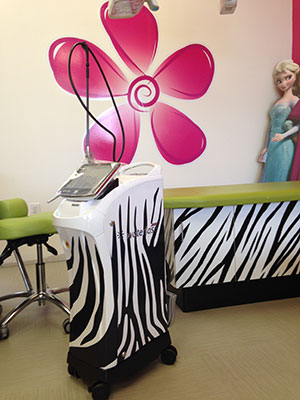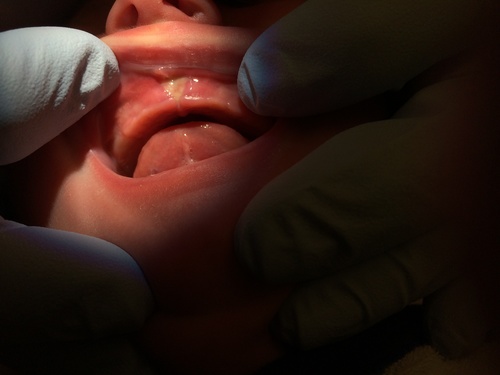Laser Dentistry

Dr. Kim uses her LightScalpel CO2 laser for tongue-tie / lip-tie releases and all other soft tissue procedures.
She has been performing releases for over 7 years. Dr. Kim has completed numerous courses including The Tongue-Tied Academy, In office training by Colorado Children's Hospital staff, she is also a member of Dr. Zaghi's Breathe Institute. Dr. Kim takes continuing education classes frequently so she always up to date on the most current procedures and techniques.
The LightScalpel CO2 laser is a device that produces a concentrated beam of light. The highly focused CO2 laser beam vaporizes, cleanly and precisely, while sealing blood vessels at the same time. Years of experience in medicine and oral surgery went into the design of the LightScalpel laser, which was made to provide superior care for patients.
Download Forms
Breastfeeding questionnaire and history form (most important)
Form/Content Graciously Provided by Dr. Ghahreri
 Meet Zoe The Zebra, our Waterlase laser.
Meet Zoe The Zebra, our Waterlase laser.
Zoe has allowed us to not use a drill or give shots, in most situations, so many procedures can be done with no anesthetic. Dr. Feuquay is one of the few Pediatric Dentists in The Woodlands who offers laser dentistry. She was also trained on site, in office, by lead instructors from The Children’s Hospital in Denver, in performing frenectomy. Dr. Kim works with several local lactation and speech consultants in evaluating the need for this procedure and performs them in the comfort of her office.
Before Your Visit
What is a frenotomy?
A frenotomy or frenectomy is a procedure used to correct a congenital condition in which the lingual (tongue) or labial (upper lip) frenulum is too tight, causing restrictions in movement that can cause significant difficulty with breastfeeding, and in some instances, other health problems like dental decay or spacing, speech difficulties and digestive issues. When it affects the lingual frenulum, this condition is commonly called a tongue tie (the medical term is ankyloglossia). Approximately 5% of the population has this condition, so your lactation consultant or doctor may feel that a procedure is warranted to improve symptoms.
How to prepare for the procedure
The best way to prepare for the procedure is to have the medications that you will need on hand so you can focus on your child following the procedure.
Tylenol - Dosage: Using the dropper in the manufacturer's packaging. This can be given every 6-8 hours after the procedure. The concentration of Tylenol should be the 160mg/5mL dosage. Some places may sell a concentrated form at 80mg/0.8mL - this is not the one I want you to use.
- 6-11 pounds - 1.25mL
- 12-17 pounds - 2.5mL
- 18-23 pounds - 3.75mL
- 24-35 pounds - 5mL
For children 6 months of age or older, you may use ibuprofen instead (or with Tylenol). Please follow the dosing instructions on the package.
You may use whatever works for your family. This includes homeopathic remedies like arnica or Rescue Remedy, or nothing at all. Because numbing medicine is used during the procedure, and because the laser itself has some analgesic properties, not everyone needs a medication beforehand.
During Your Visit
What to Expect
In general, the procedure is very well-tolerated by children. We take every measure to ensure that pain and stress during the procedure is minimized.
- General anesthesia is not utilized in the office and is almost never needed to perform the procedure.
- For babies under the age of 12 months, a topical numbing cream is applied to the area(s) that will be treated. This medication works very quickly.
- For children 12 months of age or older, numbing cream is applied. In some instances, an injected local anesthetic may be applied for additional anesthesia.
- Crying and fussing are common during and after the procedure. In older children, we have the option of giving an oral dose of Versed (midazolam), which is a relaxing medicine similar to Valium. It is very safe in children and begins working in 20-30 minutes. It helps alleviate separation anxiety in addition to providing an amnesia-like effect during the procedure. It lasts about 90-120 minutes.
- You may breastfeed, bottle-feed, or soothe your baby in any manner you'd like following the procedure. You may stay as long as necessary.
Aftercare
There are two important concepts to understand about oral wounds:
- Any open oral wound likes to contract towards the center of that wound as it is healing (hence the need to keep it dilated open).
- If you have two raw surfaces in the mouth in close proximity, they will reattach.
I feel that post-procedure stretches are key to getting an optimal result. These stretches are NOT meant to be forceful or prolonged. It's best to be quick and precise with your movements. I feel that getting an affordable LED headlight (like a camping headlight) allows you to get the best results.
You may use Tylenol, Ibuprofen (if 6 months of age or older), arnica, Rescue Remedy or other measures to help with pain control. Previously, we recommended the use of Hyland's Teething Gel or Orajel Naturals. As of October 2016, the FDA has requested that these gels no longer be used. A suitable replacement is an organic coconut oil, which can be safely used in the mouth following the procedure.
The main risk of a frenotomy is that the mouth heals so quickly that it may prematurely reattach at either the tongue site or the lip site, causing a new limitation in mobility and the persistence or return of symptoms. The exercises demonstrated below are best done with the baby placed in your lap (or lying on a bed) with the feet going away from you.

How to approach your child when doing stretches:
Examination Technique For Tongue-Tie and Lip-Tie
Examination Technique For Tongue-Tie and Lip-Tie from Bobby Ghaheri on Vimeo.
Stretches
A small amount of spotting or bleeding is common after the procedure, especially in the first few days. Because a laser is being used, bleeding is minimized. Wash your hands well prior to your stretches (gloves aren't necessary). Apply a small amount of the teething gel to your finger prior to your stretches.
TIMING: DO ONE STRETCH ON THE EVENING OF SURGERY. THEN, SKIP AHEAD TO THE NEXT MORNING (KEEP IN MIND THAT THIS IS THE ONLY TIME THAT YOU SHOULD SKIP THE OVERNIGHT STRETCH). My recommendation is that stretches be done 6x/day for the first 3 weeks, and then spending the 4th week quickly tapering from 6 to 5 to 4 to 3 to 2 to 1 per day before quitting completely at the end of the 4th week. I find it's easiest for parents to do 5 of the stretches during their waking hours and one of those stretches in the middle of the night, taking care to not go more than 6 hours between stretches. diaper changes are a good time to do the exercises.

Courtesy of Dr. Shervin Yazdi. The wounds created are typically diamond-shaped. This diamond has 3 dimensions - height, width and depth. This is especially important for the tongue wound, which is much deeper than the lip wound. Maintaining these 3 dimensions is the key to successful healing.
The Upper Lip is the easier of the 2 sites to stretch. If you must stretch both sites, I recommend that you start with the lip. Typically, babies don't like either of the stretches and may cry, so starting with the lip allows you to get under the tongue easier once the baby starts to cry. For the upper lip, simply place your finger under the lip and move it up as high as it will go (until it bumps into resistance). Then gently sweep from side to side for 1-2 seconds. Remember, the main goal of this procedure is to insert your finger between the raw, opposing surfaces of the lip and the gum so they can't stick together.
The Tongue should be your next area to stretch. Insert both index fingers into the mouth (insert one in the mouth and go towards the cheek to stretch out the mouth, making room for your other index finger). Then use both index fingers to dive under the tongue and pick it up, towards the roof of baby's mouth. The tongue needs three separate stretching motions:
- Once you are under the tongue, try to pick the tongue up as high as it will go (towards the roof of the baby's mouth). Hold it there for 1-2 seconds and then relax. The goal is to completely unfold the diamond so that it's almost flat in orientation (remember, the fold of the diamond across the middle is the first place it will reattach). The key to the success of this stretch is that your fingers are placed deep enough prior to lifting the tongue up. Picture how a forklift works: If you don't get the forklift tynes completely under the pallet, lifting the pallet up will cause it to tip backwards. If you get the tynes completely under the pallet, you can lift the pallet straight up. I recommend pushing your index fingers together to prevent them from separating, push towards the diamond and then make sure the tongue goes up and not backwards. If your fingers separate and go on either side of the diamond, your lifting pressure will be directed at the sides of the tongue and not at the diamond itself.
- With one finger propping up the tongue, place your other finger in the middle of the diamond and turn your finger sideways and use a lifting motion from front to back to try and keep the diamond as deep as possible. Use a lifting motion when you sweep through the diamond, trying to separate the horizontal fold across that diamond. Make sure your finger starts within the diamond when doing this stretch.
- Massage on either side of the diamond (outside the diamond) to loosen up the musculature of the remainder of the floor of mouth. You can use more pressure when doing these stretches because you aren't in the wound at this point.
Post-Procedure Exercises
Post-Procedure Exercises from Bobby Ghaheri on Vimeo.

Improper tongue stretch technique
This is an example of an improper stretch. Do you see how the fingers are away from the diamond? As these fingers lift up the tongue, too much of that force is directed at the sides of the tongue, and the middle portion is still pinned down. This will lead to reattachment.
Focus on getting your index fingers mentally glued together - this forces you to stay in the middle, right on top of the diamond. As you push into the diamond and then lift the tongue up, the top half of the diamond will ideally come away from the bottom half of the diamond. It is attention to separating the fold across the diamond that results in a successful post-operative stretching regimen.
Sucking Exercises
It's important to remember that you need to show your child that not everything that you are going to do to the mouth is associated with pain. Additionally, babies can have disorganized or weak sucking patterns that can benefit from exercises. The following exercises are simple and can be done to improve suck quality. I would start these on the 3rd day following the procedure, and spend 30-45 seconds on each exercise prior to the wound stretches (no need to do these sucking exercises during your nighttime stretch).
- Slowly rub the lower gumline from side to side and your baby's tongue will follow your finger. This will help strengthen the lateral movements of the tongue.
- Let your child suck on your finger and do a tug-of-war, slowly trying to pull your finger out while they try to suck it back in. This strengthens the tongue itself. This can also be done with a pacifier.
- Let your child suck your finger and apply gentle pressure to the palate, and then roll your finger over and gently press down on the tongue and stroke the middle of the tongue. Alternatively, once the baby starts to suck on your finger, just press down with the back of your nail into the tongue. This usually interrupts the sucking motion while the baby pushes back against you.
- With one index finger inside the baby's cheek, use your thumb outside the cheek to massage the cheeks on either side to help lessen the tension.
Starting several days after the procedure, the wound(s) will look white and/or yellow and will look very similar to pus.
This is a completely normal inflammatory response. Do not let your child's regular doctor, lactation consultant, friend who thinks they're an expert, or anyone else make the determination for you. If you think an infection exists, give our office a call.

5 days post-procedure (the neon yellow color can happen in babies with jaundice and is normal

1 week post-procedure

10 days post-procedure

5 days post-procedure

1 week post-procedure

11 days post-procedure
It is essential that you follow-up with your lactation consultant after the procedure to ensure optimal results.
Call our office for any of the following:
- Uncontrolled bleeding
- Refusal to nurse or take a bottle
- Fever > 101.5
Forms/Content Graciously Provided by Dr. Ghaheri


